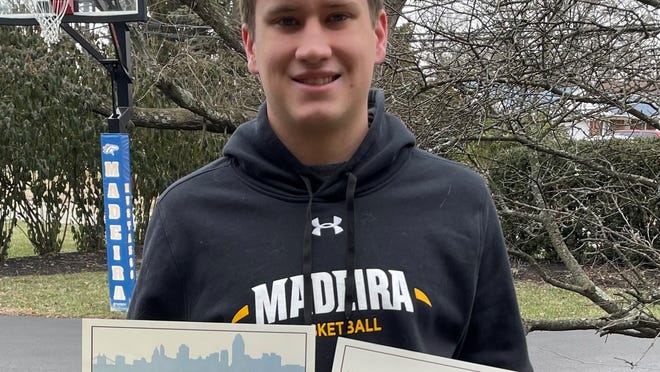
MARYSVILLE, Wash. — Steve Jahn stood on the top of his driveway watching the final ambulance pull out. The first took his wife of 32 years two days before. The second took his father-in-law. The third, his mother-in-law.
It was eight weeks after the first known U.S. case of COVID-19 was reported in his home of Snohomish County, Washington.
He closed his eyes and prayed on the asphalt.
"The whole thing was surreal," said Jahn, 62, who sells ambulances and fire trucks. "It was the one, two, three succession of having all three of them go in a matter of three days."
For his wife, Peggy Jahn, 62, memories of that day are blurry – except for one. In the middle of the night, hours after she was rolled into a small isolation room at Providence Regional Medical Center, a doctor came in to deliver the news.
"You’re not going to survive this," Peggy recalled him saying. "Call your family. Let your family know that you’re not going to make it."

Snohomish County natives Steve and Peggy Jahn met on a blind date in 1988. He was a single dad raising his son while working as a volunteer firefighter and emergency vehicles salesman. She was working for a marketing company in downtown Seattle.
"I found myself saying, 'I think I’m in love with you,' like a few weeks down the road," Steve said last week, as he sat clutching Peggy's knee and casting her a sidelong grin on their back patio. "We think it was inspired from above, to be honest with you, because there’s no other logical explanation for it, as is her recovery."
They barely spoke on their first date, but they felt the chemistry instantly. Steve invited Peggy over with a couple of friends and cooked hamburgers before taking her out to see "Die Hard." Within six months, they were married.


Peggy and Steve Jahn were married on Jan. 21, 1989, in Edmonds, Washington. Peggy's brothers walked her down the aisle to the theme song of the 1950s sitcom 'Leave It to Beaver' played on a harp.
Peggy and Steve Jahn were married on Jan. 21, 1989, in Edmonds, Washington. Peggy's brothers walked her down the aisle to the theme song of the 1950s sitcom 'Leave It to Beaver' played on a harp.
Peggy and Steve raised four kids together in Steve's childhood home on the Tulalip Tribes Reservation, overlooking Tulalip Bay in Snohomish County, just north of Seattle. Four years ago, they moved into a house further inland, in Marysville, so that Peggy's 95-year-old mom, Lillian Wattum, and her husband, Howard Stiles, 90, could move in with them.
When their local hospital admitted the first known U.S. coronavirus patient on Jan. 20, 2020, Peggy and Steve read about it in the newspaper. It was "weird," Steve said.
Peggy fell sick in early March after a long day of running errands. She went to bed that night, exhausted, and didn't leave for 10 days. When Steve returned from a business trip, they scheduled a telehealth appointment for Peggy, and the doctor said she likely had the flu.
By March 11, Peggy still wasn't better, and Howard was feeling ill, too.
"Of course, there was more news about the virus at that point, so I took him up to a nearby clinic and we had him tested," Steve said. "On Friday the 13th of all days, his test came back positive for COVID. At that point, I’m like, oh my gosh, this seems to be the real deal."
Doctors said she wouldn't survive COVID-19. After 25 days on a ventilator, she's back home
After a year of COVID-19, that left Snohomish County resident Peggy Jahn on a ventilator for 25 days, she was able to come home to her family.
Harrison Hill, USA TODAY
Quarantined at home with Steve and her parents, Peggy had a second telehealth appointment. This time, doctors advised her to come in. She wanted to take a shower before heading to the hospital, but she never made it to the bathroom. The room turned blurry: all she could see was grey.
Steve watched in horror as Peggy bent over and gasped for breath. He shifted into first responder mode and called 911.
By the time staff took her vitals at the hospital, Peggy's oxygen levels were dangerously low. It was late that night when the pulmonologist told her she wasn't going to make it.
"It didn’t register with me. I tried calling my daughter, but she didn’t have her phone on. And I got a hold of my son, but he was trying to be positive," Peggy said. "I texted my friends, the ones that I wanted to let know. I said, 'I love you. I’m not supposed to survive this.'"
Steve got a call, then a selfie of Peggy with her oxygen mask on, "looking like death on the edge." The two decided she would go on a ventilator that day, March 15.
"We texted pretty much non-stop until 6:59 a.m., and that’s when she said I’m in ICU now and they’re going to vent, and then, boom," Steve said. "That was the last communication I had with her until nearly the first week of April."
As the medical staff prepared to sedate Peggy to intubate her, she recalls hearing two final words before weeks of silence: "Let's go."
The first US case. The first death. The first nursing home outbreak: A year after COVID-19 arrived in the US, the front line staff in Washington are still holding on

As the sun rose that interminable day on March 15, Howard took a turn for the worse. His oxygen levels were starting to drop, and he was having greater difficulty breathing. Steve called for the ambulance again and the same archaic, "ratty-old bone box came," he said.
Lillian had a low-grade fever. When Peggy’s two brothers arrived, the group decided Lillian might as well go to the hospital, too, due to her age. With his brother-in-laws, their wives and kids, Steve prayed on the driveway.
"We just prayed for a miracle," he said. "Oddly enough, within four or five hours, the hospital called and said, hey, you need to come and get your mother-in-law, she’s not sick enough to stay here."

Lillian Wattum, 95, stands with her husband, Howard Stiles, 90, in their home in Marysville, Washington, on Jan. 13, 2021. "I'm a cougar because he's four years younger than me," Lillian said with a chuckle. They were married 10 years ago.
Steve picked Lillian up at the hospital that evening. Isolated and missing their partners, the pair clung to one another, and to their community. As word spread of the family's situation, members of their church began to leave food at the door, and some gathered to sing hymns in the backyard. Steve opened the sliding glass door and sang along from a distance as Lillian sat with her eyes closed and hands raised.
"It was one of the most blessed yet hardest times of my entire life," Steve said.
Meanwhile, Steve was calling the hospital several times a day. He wanted to know if Peggy or Howard was eligible to receive remdesivir, an antiviral drug originally developed to treat Ebola. Howard received the treatment and was discharged March 25, after 11 days in the hospital. Peggy was too sick to get the drug through the trial but finally received it through compassionate use.
As Peggy remained in the hospital, the youngest kids, Peter, 30, and Heidi, 29, came to stay with their dad. They kept friends and relatives – including some as far as Norway – updated on Peggy's situation through a Facebook page, where the group shared photos, messages and music.
Steve tried to stay busy. He did laundry, swept, vacuumed, mopped, mopped again. When his kids put down their cups, he'd place them in the dishwasher before they were even done with them.
"They'd say, 'dad!' And I'd say, I have to maintain some order. It’s all I can do," Steve said. "I've run a company. I’ve been a fire chief. I’m used to making decisions and making stuff happen. And I couldn’t do anything, and that was the hardest thing."
Steve couldn't bring himself to enter his bedroom. Most nights he slept on a downstairs recliner, next to the home phone, staring at it before he went to sleep around 2 a.m.
"It was like a hand grenade with the pin pulled, and I’m just waiting for it to explode," he said. "I felt if that house phone rang ... I was going to get the news that I didn’t want to get. So every morning I'd say 'thank you, God,' that phone didn’t ring last night."
Steve began wearing Peggy's rings on a gold chain, clutching them like rosary beads. One night, in late March, he glanced in the mirror and saw the rings on his chest.
"I just kind of lost it. That’s the first time I actually lost it," Steve said. "And I just looked up and said, God, either give her back or take her."
Days later, the grenade exploded.
Two doctors were on the phone, asking Steve to come in to discuss "Peggy's transition." Steve was escorted up to the sixth floor of the hospital on April 6.
The doctors stopped Steve just outside Peggy's room. They had placed a trach in her throat, and she was going to need a feeding tube. She may never again be the Peggy he knew, they told him: Did he want to put her through that?
Steve got 10 minutes in the room with Peggy. He knelt down beside her bed. "Hey, honey, I’m here. I’m here," he said. Her eyes moved just a hint, and Steve walked around the other side of her bed.
"She slowly turned her head my way. So I’m like OK, she’s responding. She hears us," he said.
Steve walked out of the room knowing that Peggy was going to make it. That night, he got a call from a nurse telling him that Peggy had wiggled her toes on command, twice.
"That was the first thing I remember was wiggling my toes," Peggy said.
It was the beginning of her recovery. And the start of her delirium.

Peggy finally came off the ventilator on April 8, after 25 days.
A few days later, Steve received a FaceTime call around 3 a.m. It was Peggy. She couldn't speak with the trach in her throat, but she was flailing around and trying to communicate something. Steve dialed the hospital.
"I’m like, good gosh, I’m going to see her die on FaceTime in the hospital," he said.
A nurse finally rushed into the room and checked Peggy's vitals. Everything was normal, but Peggy was trying to mouth words. She handed Peggy a dry erase board.
"So she writes and the nurse holds it up: 'Come get me.' And I’m like, oh, honey, I wish I could come get you," Steve said.
Doctors say it's common to experience delirium in the ICU. But the sensation was "freaky weird," Peggy said.
She spoke to her family again for the first time the day after Easter, Peter's 30th birthday, babbling on about how her phone had been hijacked and the nurses were plotting against her.
"I don’t remember much," Peggy said. "I just remember a mom has to talk to their kid on their birthday, and I missed his birthday."
Peggy spent 42 days in the hospital. She lost her hair and had to learn to walk again after losing muscle while in paralysis on the ventilator. The first time she worked with physical therapists, Peggy could barely lift her toes. Before she was discharged, she had to walk 25 steps.
Her goal, Peggy told the physical therapists, was to be able to hold a weed wacker and do her own yard work again. But the physical therapists couldn't promise her that, or that she'd ever drive again.
‘I’m really fighting a storm’: Snohomish, King communities describe year since COVID-19 arrived there
Steve picked Peggy up from the hospital April 24. On the drive home, Steve showed Peggy the empty hotel parking lots and barren malls. When she had gone to bed in her room in early March, life was normal. She emerged from the hospital to what Steve called "the apocalypse."
As the two pulled into the driveway, Peggy saw posters of support lining both sides of the asphalt. "It was very overwhelming," she said.

As Peggy continues her recovery at home, she's walking. She's weed wacking. She's remodeling the bayside home where she and Steve raised their children. Last week, Peggy hopped in the car and drove the 20 minutes out to the house.
Days after a historic windstorm wiped out power to the county, the water was still. Peggy roamed the house, ripping up carpet and sharing memories. She propped up a ladder in her daughter's old room and began covering the chipped paint with a fresh coat.
Steve stood on the back deck, watching two seals bobbing in the water and pointing to two bald eagles that had landed in their tree. He's still processing the trauma of what happened. After 20 years in the fire department, he never had PTSD. Now he does.
Steve said the experience, as stressful as it was, has helped him break down some walls with his kids that he didn't even know were there. For Peggy, her kids are finally answering her phone calls.


Peggy Jahn makes it up the 16 steps to the upper floor of her home in Marysville, Washington. “I’m not going to stop,” Peggy said last week. “Now, I’m doing up to 10,000 steps a day because I can. Because I can. It’s a gift I’ve been given back.”
Peggy Jahn makes it up the 16 steps to the upper floor of her home in Marysville, Washington. “I’m not going to stop,” Peggy said last week. “Now, I’m doing up to 10,000 steps a day because I can. Because I can. It’s a gift I’ve been given back.”
Courtesy of the Jahn family
"I think the kids appreciate mom a whole lot more," she said with a wink. "I can get away with a lot more."
This week, as staff at Providence Regional Medical Center paused and the nation observed a moment of silence for the 400,000 souls lost to COVID-19 in the U.S., Peggy and Steve celebrated their 32nd wedding anniversary. On Sunday, they're renewing their vows outside their church.
Steve had re-proposed on April 15, as Peggy was leaving the ICU after 32 days.
Her hand shook as she held it up to her face in her hospital bed.
In their living room 15 miles away, Steve got down on one knee, dressed in a T-shirt and pajama pants.
"I clearly feel like I’ve been given a second chance to share what’s already been an amazing 31 years," he said into his phone. "I just want to say, Peggy Jahn, would you remarry me at your earliest convenience?"
Peggy cracked a smile: "Come and get me."
Reach reporter Grace Hauck at [email protected] or on Twitter at @grace_hauck.
More from USA TODAY:
Biden faces pressure to deliver in 'wartime' effort against COVID-19 crisis
Acceptance of COVID-19 vaccine is rising, but so is pessimism about getting back to normal









